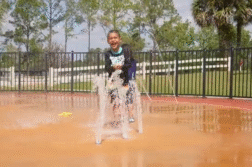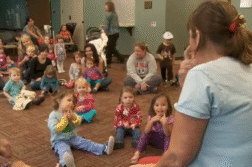NEW YORK, N.Y. (Ivanhoe Newswire) – An ACL – or anterior cruciate ligament tear – is one of the most common knee injuries in the U.S., with between 150,000 and 200,000 occurring each year, primarily in professional and amateur athletes. Until recently, patients undergoing reconstructive surgery had only two choices: use their own tissue for the repair or take it from a cadaver. But now, there’s a third option. BEAR Implant
Sixteen-year-old Kelis Guzman is recovering from an ACL tear – an injury she sustained while playing a friendly game of soccer.
“I landed weird on my left knee and so, then, I heard, like, a pop and a crack,” Guzman painfully recalls.
Doctors gave Guzman two surgical options – a bridge-enhanced ACL restoration, better known as a BEAR implant, or the traditional procedure.
Yair Kissin, MD, Vice Chair at the Hackensack University Medical Center, explains the traditional procedure as, “Taking another ligament from somewhere else, and then replacing it where the torn ACL, currently, is no longer there.”
Approved by the FDA in 2020, a BEAR implant doesn’t rely on human tissue, it’s made from bovine collagen to bridge the gap between the torn ends of a patient’s ACL. The implant is absorbed by the body, which replaces it with its own tissue, eliminating the need to harvest a ligament from the patient’s, otherwise, healthy knee or rely on a cadaver part.
“There is some data that shows by preserving as much of the patient’s native ACL, you are also preserving some of those proprioceptive fibers that help with keeping a knee more stable,” adds Section Chief at the same hospital, Amit Merchant, DO.
Both options have the same nine month to a year recovery period, so, Guzman – who hopes to play soccer in college – chose a BEAR implant because she didn’t want to use her own ligament. Aside from the stiffness that’s associated with the procedure, she says the discomfort is minimal.
The BEAR implant isn’t an option for everyone. It’s indicated for skeletally mature patients who have some remaining ACL tissue.
Contributors to this news report include: Sherry Karabin, Producer; Nate McCallister, Videographer; Roque Correa, Editor.
To receive a free weekly e-mail on medical breakthroughs from Ivanhoe, sign up at: http://www.ivanhoe.com/ftk
MEDICAL BREAKTHROUGHS
RESEARCH SUMMARY
TOPIC: BEAR IMPLANT PRESERVES THE ACL
REPORT: MB #5274
BACKGROUND: A torn ACL can heal much faster now due to three new surgical advancements in the field of ACL’s — cadaver transplants, patellar tendon grafts, and hamstring tendon grafts. With cadaver transplants, tendons and ligaments are taken from different parts of a deceased individual’s leg, a graft is created, and then inserted into the injured person’s body. While it’s a less invasive option than others, some people run the risk of their bodies rejecting the foreign tissue. With the patellar tendon graft, a portion of the individual’s bone as well as their tendon is injected into their body. Since the body heals bones, it accepts the transplant and begins to rectify what’s broken. Finally, the hamstring tendon graft uses your own tissue (with bone attached to it, this is known as “bone plugs”) and fastens itself to the tibia and femur. With time, the body creates new bone around the bone plug and takes the place of the original ligament.
(Source:
DIAGNOSING: To diagnose an ACL injury, the physician will use your uninjured knee to assess the state of your injured knee. Usually, they’ll bend the knee in different positions to measure your range of motion as well as evaluate for swelling or soreness. In most cases, it’s evident through a physical exam that an ACL trauma has occurred. However, to gauge the severity of it, tests such as x-rays, MRIs, and ultrasounds can be performed to rule out fractures or damage to surrounding tissue. The Lachman test is most routinely used by physicians to diagnose an ACL tear. Once completed, there are two ways to detect which kind of ACL injury is present. First, pay attention to how often the knee and shin bone move during the test. When the knee and shin move, the role of the ACL is to keep them within a limited range of motion. If during the test they move more than normal, there’s a high chance an ACL injury has occurred. Next, consider the firmness of the ACL. If the ACL is jerky and not firm when completing a movement, it might be ripped or worse.
(Sources:
https://www.mayoclinic.org/diseases-conditions/acl-injury/diagnosis-treatment/drc-20350744
https://www.healthline.com/health/lachman-test#grading)
NEW TECHNOLOGY: A BEAR implant, also known as the Bridge Enhanced ACL Restoration, is a revolutionary procedure that treats ruptured or torn ACLs. ACL stands for Anterior Cruciate Ligament — it is a pliable band of tissue that joins the bottom of the femur (thighbone) to the top of the tibia (shinbone). This ligament is what helps to keep our knee stable. Through the new BEAR technique, no longer does ACL reconstruction require the aggressive, and often complicated, surgical procedures done in the past. The BEAR technique uses a medical device referred to as ‘BEAR Implant’ to close the space between the torn anterior cruciate ligaments (ACL). The implant uses bovine collagen, a protein typically taken from cows, and applies that to the non-cellular portion of the ACL to treat it. To perform the procedure, a small incision is made on the wound site to make way for the implant. It’s placed right between the two torn ACL ends. Then, the patient’s blood is added to the implant to incite blood clot formation. Eventually, this action will be what helps support cell growth (proliferation) and cellular migration. Finally, the torn ACL ends are stitched unto the BEAR implant. Within an eight-week window post procedure, the implant will have absorbed into the body and been replaced by new cells and tissues. In time, they’ll become new strong ligaments.
(Sources:
https://www.pinnacle-ortho.com/bridge-enhanced-acl-restoration-bear-implant
https://kidshealth.org/en/teens/acl-injuries.html
https://draxe.com/nutrition/bovine-collagen/)
FOR MORE INFORMATION ON THIS REPORT, PLEASE CONTACT:
Mary McGeever
If this story or any other Ivanhoe story has impacted your life or prompted you or someone you know to seek or change treatments, please let us know by contacting Marjorie Bekaert Thomas at mthomas@ivanhoe.com




